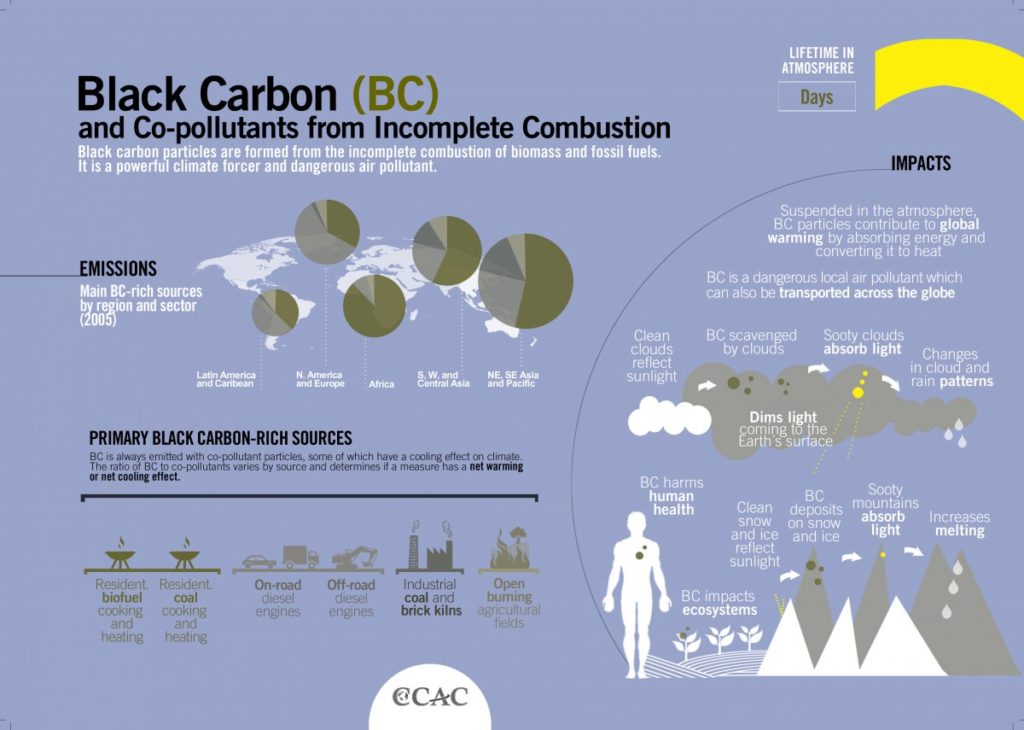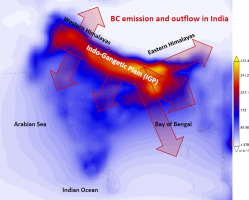Focus: GS-III Environment and Ecology, Prelims
Why in news?
Black carbon concentrations near the Gangotri glacier rose 400 times in summer due to forest fires and stubble burning from agricultural waste, and triggered glacial melt, says a study by scientists at the Wadia Institute of Himalayan Geology (WIHG).
Details
- The team of scientists from WIHG- measured variations of black carbon concentration at Chirbasa, near the Gangotri glacier in the Indian Himalaya, and located at an altitude of 3,600 metres, during the year 2016.
- The monthly mean concentration of EBC (equivalent black carbon) was found to be minimum in August 2020 and maximum in the month of May 2020.
- The observed seasonal mean concentrations of EBC indicated a pristine glacial source and an absence of EBC sources in the locality
What is Black Carbon?
- Black carbon is a potent climate-warming component of particulate matter formed by the incomplete combustion of fossil fuels, wood and other fuels.
- Complete combustion would turn all carbon in the fuel into carbon dioxide (CO2), but combustion is never complete and CO2, carbon monoxide, volatile organic compounds, and organic carbon and black carbon particles are all formed in the process.
- The complex mixture of particulate matter resulting from incomplete combustion is often referred to as soot.

Adverse Effects of Black Carbon
- Black carbon is a short-lived climate pollutant with a lifetime of only days to weeks after release in the atmosphere.
- During this short period of time, black carbon can have significant direct and indirect impacts on the climate, glacial regions, agriculture and human health.
- Several studies have demonstrated that measures to prevent black carbon emissions can reduce near-term warming of the climate, increase crop yields and prevent premature deaths.
- Black carbon absorbs solar energy and warms the atmosphere.
- When it falls to earth with precipitation, it darkens the surface of snow and ice, reducing their albedo (the reflecting power of a surface), warming the snow, and hastening melting.
India and Black Carbon Emission
- India is the second largest emitter of black carbon in the world, with emissions expected to increase dramatically in the coming decades.
- Indo Gangetic plains are found to be the largest contributor.

Extra Coverage:
Brown Carbon:
- Brown carbon is a carbonaceous aerosol which absorbs solar radiation over a broad range of wavelengths which is beginning to be seen as an important contributor to global warming.
- Brown Carbon absorbs both inorganic and organic pollutants, leading to serious effects on human health. Hence, Brown carbon (light-absorbing organic carbon) has attracted interest as a possible cause of climate change.
- Brown Carbon is a class of organic carbon, known for its light brownish colour, absorbs strongly in the ultraviolet wavelengths and less significantly going into the visible.
- Types of brown carbon include tar materials from smouldering fires or coal combustion, breakdown products from biomass burning, a mixture of organic compounds emitted from soil, and volatile organic compounds given off by vegetation.
| Brown Carbon | Black Carbon |
| Brown Carbon is brown in colour and its absorption is limited to UV and lower visible wavelengths. Aerosol absorption depends on the mass, mixing state, chemical composition and the refractive index of the species present in the atmosphere. | The ratio of Black Carbon to organic mass determines the colour of the particles which is in turn influenced by the burning conditions. Black carbon is dark in color and shows strong light absorbing capacity throughout the spectra. |





